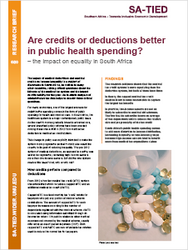Research Brief
Are credits or deductions better in public health spending?
The impact on equality in South Africa
The impact of medical deductions and medical credits on income inequality is a subject of discussion in South Africa, as well as in many other countries, raising critical questions about the fairness of the medical tax system and the impact on affordability for the poor. An in-depth analysis of administrative tax data helps to answer these critical questions.
The research evidence shows that the medical tax credit system is more equalizing than the deduction system, but both of them have flaws
In theory, the capped medical tax credit enables lower income households to capture the largest tax benefits
In practice, low-income earners are not as likely to subscribe to medical aid schemes. The few that do subscribe insure an average of two dependents which reduces the relative size and progressivity of the tax credit
South Africa’s public health spending seems to add more distortion to income distribution, increasing inequality across income groups because high-income earners tend to benefit more from medical tax expenditure claims
For many economies, one of the largest avenues for redistributive spending comes in the form of public spending for health and medical care. In South Africa, the healthcare system is a major contemporary policy issue. As the country moves gradually towards universal care, several important policy reforms have been enacted. Among these was a shift in 2012 from medical tax deduction to medical tax credit system.
This change in policy was explicitly intended to make the system more progressive so that it would also assist the country in its goal of reducing inequality. The pre-2012 system of medical deductions, as opposed to credits, was said to be regressive, rewarding high-income earners more than low-income earners. But did the new system resolve this issue? And, why or why not?
How credits perform compared to deductions
From 2012 a two-tier medical tax credit (MTC) system was established which includes a capped MTC and an additional medical tax credit (AMTC).
 Capped MTC is a fixed monthly tax ‘credit’ rebate for taxpayers who pay any portion of medical scheme contributions. The amount of capped MTC for each taxpayer increases according to the number of dependents registered with the medical scheme. AMTC is calculated using information submitted through an income tax return. It is paid in relation to other medical expenses not covered by the medical scheme, usually referred to as out-of-pocket expenses (OOP). Both capped MTC and AMTC are non-refundable tax rebates used to reduce the normal tax for taxpayers.
Capped MTC is a fixed monthly tax ‘credit’ rebate for taxpayers who pay any portion of medical scheme contributions. The amount of capped MTC for each taxpayer increases according to the number of dependents registered with the medical scheme. AMTC is calculated using information submitted through an income tax return. It is paid in relation to other medical expenses not covered by the medical scheme, usually referred to as out-of-pocket expenses (OOP). Both capped MTC and AMTC are non-refundable tax rebates used to reduce the normal tax for taxpayers.
The administrative tax data analysis shows that taxpayers with annual taxable income between ZAR150,000–750,000 (US$11,190–55,970) constitute 76% of taxpayers who benefit from the tax credit system. This shows that the medical tax credit is to some extent irrelevant for most low-income earners. However, compared with the earlier deduction system, tax relief under the tax credit system is generally higher across all taxable income groups with taxpayers in lower taxable income groups capturing significant tax relief relative to taxable income.
Gini coefficients, which represent wealth distribution, show equalizing effects associated with the medical tax credit, but when it comes to the additional medical tax credit they point to an effect increasing inequality. The analysis shows that, in practice, insignificant changes in the reduction of inequality are observed across the years. This could be due to the design of the credit system, wherein an equal amount is given to all taxpayers regardless of the amount paid towards medical fees.
 The system is, overall and on average, progressive — but there are some elements of the credit which are regressive between certain demographic groups. For example, high-income taxpayers benefit more when under the age of 65 than do taxpayers with the same income older than 65 years.
The system is, overall and on average, progressive — but there are some elements of the credit which are regressive between certain demographic groups. For example, high-income taxpayers benefit more when under the age of 65 than do taxpayers with the same income older than 65 years.
What does this mean for policy-making?
The distribution in MTC shows that higher-income earners benefit more from MTC. The wealthy are most likely to subscribe themselves and their dependents to medical schemes and claim more AMTC which requires claimants to pay for medical expenses out-of-pocket, but reduces the overall amount of taxes they need to pay. Reforming the AMTC and ensuring that capped MTC continues to be inflation-adjusted in the future may address the inequality gap associated with the system.
According to the National Treasury, a risk equalization fund had been proposed — which would be part of the National Health Insurance (NHI) reform. This would expand the scope to allow for extending the tax credit benefit to those who fall below the tax threshold and others who should be entitled to refunds. However, no discussions are currently underway to reverse the non-refundable tax rebate system which favours high-income earners. A refundable arrangement would help achieve equity and proportionality, and encourage low-income earners to subscribe to medical aid schemes.
As the evidence shows that the medical tax credit system is more equalizing than the deduction system the credit system should be maintained as a necessary tax expenditure for providing medical relief to recipients
Additionally, if the refund system as proposed under the envisaged NHI risk equalization fund is eventually implemented, this would render the rebate system inclusive, covering even taxpayers below the tax threshold and promoting medical scheme subscription
One exception that is worth further interrogation is for high-income earners 65 years and older. Medical tax rebates for this age group decreased under the medical tax credit system compared to the medical deduction system.
Suggestions for further policy-relevant research
Moving forward, the analysis could be extended to yield more meaningful results by exploring the definition of low-income households in South Africa, the effects on the income distribution of the elderly, the distribution effects of persons with disability, and distributional effects of households confronted with higher medical bills.
 Join the network
Join the network